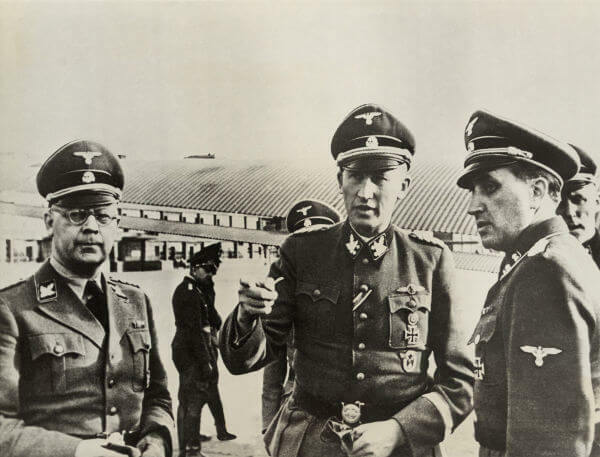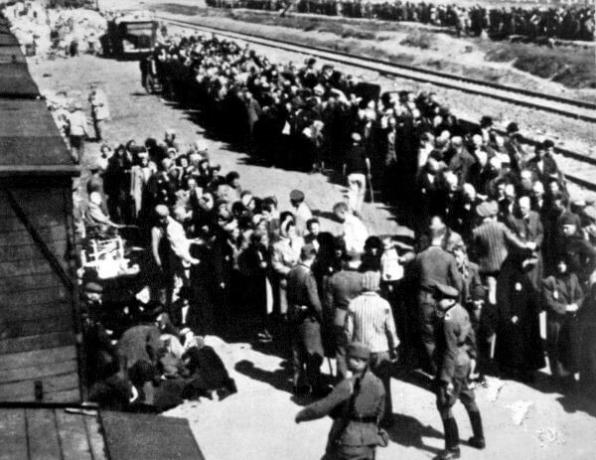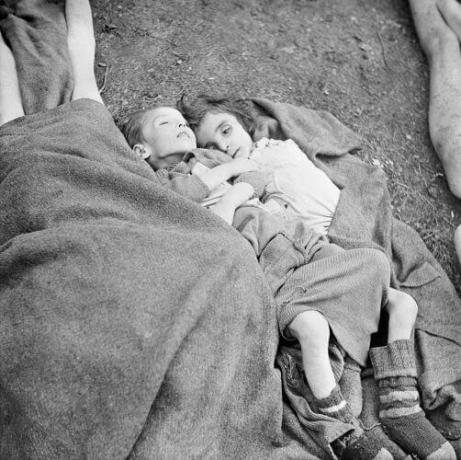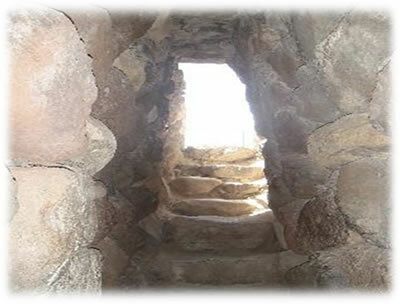Holocaust is the name given to the genocide committed by the Nazis throughout the Second World War and that killed approximately six million people between Jews, gypsies, homosexuals, Jehovah's Witnesses, disabledphysicists and mental, political opponents etc. Anyway, the group most victimized in the Holocaust was the Jews. These, in turn, prefer to refer to this genocide as shoah, which in Hebrew means “catastrophe”.
Also access:Understand whether Nazism was a left or right party
Nazi Anti-Semitism
The Holocaust was the end result of a nation-building process of hatred against a specific group living in Europe. O anti-Semitism in Germany did not come up with Nazism and dates back to mid- centuryXIX, in nationalist movements, in addition to having been manifested by German personalities of the time, such as Hermann Ahlwardt and Wilhelm Marr.
When the Nazi party appeared, in 1920, anti-Semitism was an element that was already part of the party's platform, and historians believe that Adolf Hitler became anti-Semitic at some point in his youth, when he lived in Vienna, the capital of Austria. The presence of anti-Semitism in Nazism, during its founding, was noticeable in the
party program, which stated that no Jew could be considered a German citizen.German anti-Semitism assumed that german race was higher and that the Jews they were responsible per all the evils of society German. Hitler and the Nazis began by blaming the Jews for the German defeat on First World War through the "stab-in-the-back theory."
The Nazis said that the Jews had a plan for world domination and they scathingly criticized economic liberalism and financial capitalism, as they claimed that both were dominated by the Jews. One of the clear examples of this idea (located at the time of the conspiracy theories used to accuse the Jews) was a book of Russian origin and unknown author that was a bestseller in the Germany: "The Protocols of the Sages of Zion”.
When the Nazis took power in Germany, in 1933, the process of exclusion and violence against Jews was progressively initiated. The Nazi speech, allied to the indoctrination carried out in German society, made the Jews scapegoats and victims of intense persecution, not only by the government, but also by civilians.

During the Holocaust years, the Nazis forced Jews to wear a star sewn onto their clothing as a form of identification.**
One of the first actions taken by the Nazis against the Jews was a law, passed on April 7, 1933, called Berufsbeamtengesetz, translated into Portuguese as Law for the Restoration of Professional Public Service. This law definitively prohibited Jews from acting in public office. Other laws of the kind have been passed for other trades, such as doctors and lawyers. In addition to the laws, Jews were targets of attacks promoted by the Nazi Assault Troops (SA) and had their stores boycotted nationwide.
As time went by, new actions against the Jews were being organized in Germany. This persecution forced thousands of Jews to flee the country, but many others failed, as no country was willing to receive them. In the 1930s, two measures taken by Hitler symbolized the reinforcement of anti-Semitism in Germany: Nuremberg Laws and the night of crystals.
Do not stop now... There's more after the advertising ;)
Also access:Understand once and for all what fascism is all about
Nuremberg Laws
The Nuremberg Laws were a set of three laws, passed in 1935, which legislated on the miscegenation, a flag and the german citizenship. The two laws that directly related to anti-Semitism in Germany were the German Blood and Honor Protection Act and the Reich Citizenship Law.
The first law dealt with miscegenation, prohibiting Jews and non-Jews from marrying, as well as prohibiting non-Jews from having sex with Jews. This law also said that Jews could not have maids under the age of 45 or wear the colors of the Reich (black, red and white).
The second dealt with citizenship, basically defining who was a citizen and who was not. According to this law, all people who had ¾ of Jewish blood or were practitioners of Judaism would be considered Jewish and would automatically not be entitled to citizenship. Thus, Jews were considered only “subjects of the State” and were people who had to fulfill their obligations, but were not entitled to receive anything that a citizen would receive.
night of crystals
THE night of crystals it was a milestone in the history of anti-Semitism because it officialized a starting point for the increase in violence against Jews in Germany. This event took place in 1938 and is defined as a pogrom, that is, a violent attack that is organized against a specific group.
This attack took place in retaliation for the murder of Ernst vom Rath, a German diplomat, for a 17-year-old Jewish student who wanted revenge for his parents' expulsion from Germany. Days after the German diplomat was attacked in Paris, an order was issued by Hitler and Goebbels to organize violent actions as a way of intimidating the Jews.
The Crystal Night attacks began on the night of November 9, 1930 and extended until the middle of the next day. Members of the Nazi party, mostly in plainclothes, took to an act of violence unheard of in Germany. Homes, establishments, orphanages and synagogues were attacked with the attackers destroying what found in front, attacking the people who were in these places and, finally, setting fire to the buildings.
at the end of the pogrom, thousands of establishments were destroyed, and despite the official death toll being 91, it is speculated that those killed in that attack may have numbered in the thousands. The Night of Crystals also inaugurated the imprisonment of Jews in concentration camps, as during the pogrom, 30,000 Jews were arrested and forwarded to Dachau, Buchenwald and Sachsenhausen.

Pictured are Heinrich Himmler (left) and Reinhard Heydrich (center), the two architects of the Final Solution.*
Like beginning of WWII, in 1939, the top of the Nazi party began to discuss “solutions” on how to deal with the “Jewish question” in Europe. As mentioned, the imprisonment of Jews in concentration camps began in the 1930s. These places, however, had not been prepared to be places of extermination as happened during the war.
When the war started, Jews in Eastern Europe began to be grouped into ghettos, a specific location in the city that was surrounded by Nazi troops and set aside specifically for the shelter of Jews. The ghettos grouped them together so that they could later be sent to the concentration and extermination camps.
Furthermore, the Nazis debated solutions to be put in place to deal with the “Jewish question”, and two of these were widely debated. At first, the Nazis tried to obtain authorization to deport the Jews to the Soviet Union, but Stalin refused to accept them. Another plan became known as FlatMadagascar, in which the Nazis considered deporting Jews from Europe to the island of Madagascar in Africa.

Across Europe, Jews were gathered and transported to ghettos and concentration camps in train cars.
Anyway, the plan of exterminate all Jews after the war is classified by historian Timothy Snyder as a Utopia of Hitler that was reworked by two members of the Nazi Party as the war took a turn that was not wanted by the Nazis.|1| Reformers of the Jewish extermination plan were ReinhardHeydrich and HeinrichHimmler and therefore both are considered architects of the Holocaust.
When the Final Solution was worked out, what was on Heydrich and Himmler's mind was: “Jews who could not work would have to disappear, and those physically able to work would be used as a labor force somewhere in the conquered Soviet Union until die." |2| The first Jewish victims of this plan were targeted by the Einsatzgruppen, you death squads.
These extermination groups operated in Poland, the Baltic countries and the part of Soviet territory that the Nazis were occupying. Their performance was simple: promote the systematic cleansing of Jews from these areas through shootings.. Jews from these locations were gathered at a specific location, placed naked in front of a common grave, and shot one by one until the entire Jewish population in those locations was dead.
The actions of the death squads in the aforementioned places, such as the Baltic countries (Estonia, Lithuania and Latvia), led to the death by shooting thousands of people. In Lithuania, 114.856 Jews were killed; in Latvia, 69.750 Jews were executed; and in Estonia, 963 Jews were found and all of them were executed. During these shootings, the death squads also executed others, such as those who had collaborated with the Soviets.|3|
The shooting organized by the Einsatzgruppen that was best known was named Babi Yar Massacre, when Kiev's Jews were gathered at one point in the city and shot over a period of 36 hours. This massacre resulted in the deaths of 33,761 people, who were deposited in a mass grave.|4|
The performance of the extermination groups, however, had sensitive limits to the Nazi objectives. First, as efficient as the Einsatzgruppen, the speed with which they carried out ethnic cleansing was below what the Nazis want. Second, the soldiers' involvement in a staggering number of executions brought them serious psychological problems. This forced the Nazis to think of an alternative that would make the genocide of Jews happen more quickly and impersonally.
Also access:Discover the history of the massacre of Poles carried out by the Soviet Union in 1940
concentration camps
 Corpses of Jews found in Bergen-Belsen concentration camp in 1945.*
Corpses of Jews found in Bergen-Belsen concentration camp in 1945.*
The solution found by the Nazis was to promote the execution of Jews in gas chambers, that were being installed in the concentration camps. In addition, six extermination camps were built whose sole purpose was to promote the execution of Jews. The difference is that, in the concentration camps, the Jews, in addition to being executed, also had their labor exploited to the full.
Gas chambers for the execution of Jews was an idea exported from Euthanasia Program, also known as Action T4. In this program, the Nazis executed those who were considered invalid, that is, those who had some kind of mental disorder or physical disability.

Entrance to Auschwitz, the death camp responsible for the death of 1.2 million people. On the portal it is written “work frees”.***
The extermination camps, built by the Nazis from the second half of 1941, were: Chelmno, Belzec, Sobibor, Treblinka, Auschwitz and Majdanek. All of these camps were located in Poland, and the first of them to be built was the one at Belzec—the site where a gas chamber based on carbon monoxide and who killed his victims for asphyxia. Later, other camps were built, and the Nazis started using Zyklon-B to murder the prisoners.
Of the extermination camps mentioned, the number of deaths was as follows:
- Auschwitz-Birkenau: approximately 1.2 million dead.
- Treblinka: approximately 900 thousand dead.
- Belzec: approximately 400 thousand dead.
- Sobibor: approximately 170 thousand dead.
- Chelmno: approximately 150 thousand dead.
- Majdanek: approximately 80 thousand dead.
Among the horrors committed in the concentration camps, the strenuous workday, daily abuse and poor hygiene conditions stood out. Prisoners were kept in barracks overcrowded with people and were poorly fed. Summary executions without apparent motivation took place as a form of psychological torture of prisoners, in addition to executions in the gas chambers.
 Two Jewish children who starved to death were found in the Bergen-Belsen concentration camp in 1945.*
Two Jewish children who starved to death were found in the Bergen-Belsen concentration camp in 1945.*
Prisoners received insufficient clothing for the winter, and most of the time they were collected in April (mainly in the case of Auschwitz) regardless of whether the cold had passed or not. They were forced to put up with the huge amount of bed bugs and fleas in the barracks. When they got sick, the treatment offered was always insufficient. In the medical issue, there are also records of tests performed in human guinea pigs per nazi doctors in several concentration camps.
Concentration camp prisoners were being released as the Nazis lost World War II. As their positions in Eastern Europe were threatened, the Nazis increased the speed of executions of Jews in the gas chambers, in addition to having tried to hide the evidence of the genocide, either with the destruction of documents or with the exhumation of the bodies.
Also access:See which country besides Germany built concentration camps during World War II.
Trials in Nuremberg
After the Nazis surrendered in May 1945, many of them and their collaborators, who acted directly in the Holocaust, were arrested and brought to trial in the International Military Tribunal at Nuremberg. Trials at Nuremberg stretched to nine months and sentenced some Nazis to death by hanging, while others were sentenced to life imprisonment or a certain amount of time.
Among those sentenced to death by hanging were HermannGoring, boss of Luftwaffe (air force), and joachimvonRibbentrop, Minister of Foreign Affairs of Germany. Among those sentenced to life imprisonment were Rudolfhess, deputy leader of the Nazi party, and erichraeder, commander of the Kriegsmarine (German navy).
Films
The Holocaust is one of the most important events of the 20th century. Survivors' accounts to this day shock the world, and with each passing day new information is discovered. Because it is such a relevant subject for the recent history of the world, the Holocaust is a subject that draws great attention from cinema and, therefore, great works were produced. We highlight some of them below:
- "The pianist" (the pianist), 2002 film directed by Roman Polanski.
- "Schindler's List" (Schindlers List), 1993 film directed by Steven Spielberg.
- "Life is Beautiful" (La Vita is Bella), 1997 film directed by Roberto Benigni.
- “The son of Saul” (Saulspin), 2015 film directed by László Nemes.
- "Amen” (Amen), 2002 film directed by Constantin Costa-Gavras.
|1| SNYDER, Timothy. Lands of Blood: Europe between Hitler and Stalin. Rio de Janeiro: Record, 2012, p. 235-236.
|2| Idem, p. 236.
|3| Idem, p.241-243.
|4| Idem, p. 253.
*Image credits: Everett Historical and Shutterstock
**Image credits: Chameleons Eye and Shutterstock
***Image credits: bondvit and Shutterstock
By Daniel Neves
Graduated in History

